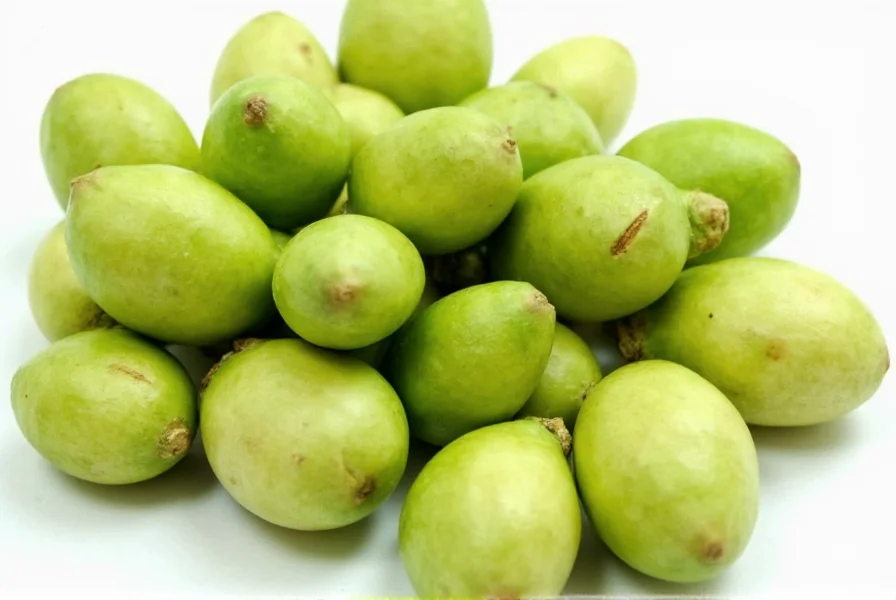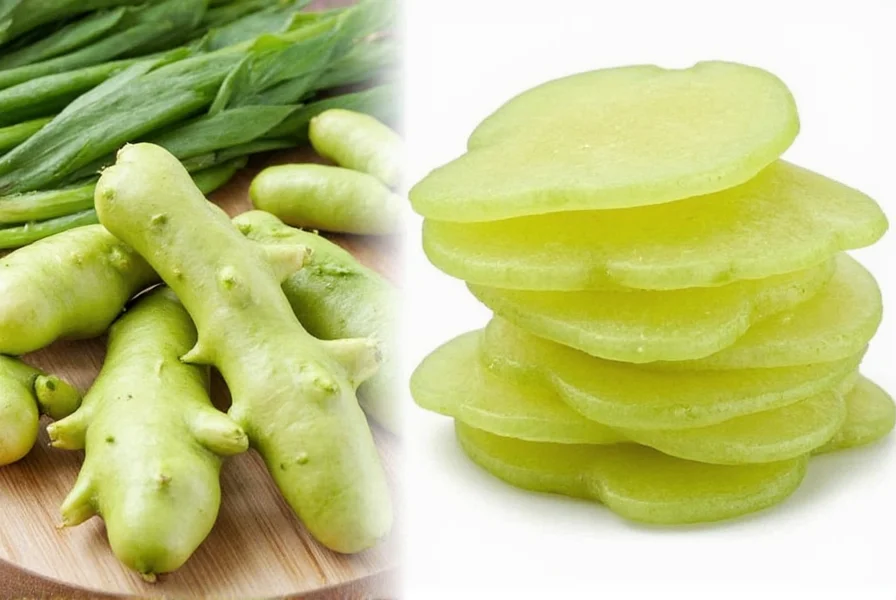Understanding the distinction between green ginger and its mature counterpart is essential for both home cooks and professional chefs. While all ginger starts as "green" or young ginger, the harvesting timeline creates significant differences in texture, flavor profile, and culinary applications. The term "green" here doesn't refer to color but rather to the developmental stage of the rhizome.
What Makes Ginger "Green"?
Green ginger, also known as young ginger or spring ginger, is harvested much earlier in the growing cycle than mature ginger—typically between 3-6 months after planting rather than the 8-10 months required for full maturity. This early harvest preserves the rhizome's natural characteristics:
- Thin, delicate skin that requires minimal or no peeling
- Higher moisture content (up to 80% water compared to 60-70% in mature ginger)
- Milder, less pungent flavor with subtle citrus notes
- Crisp, almost juicy texture similar to radish
- Pale yellow to light green flesh near the skin
As ginger matures, it develops tougher skin, fibrous texture, and the characteristic spicy heat from increased gingerol compounds. The "green" designation specifically indicates this youthful stage before these transformations occur.

Green Ginger vs. Mature Ginger: Key Differences
| Characteristic | Green Ginger | Mature Ginger |
|---|---|---|
| Harvest Time | 3-6 months | 8-10 months |
| Skin Thickness | Very thin, almost translucent | Thick, tough, fibrous |
| Flavor Profile | Mild, slightly sweet, citrus notes | Strong, pungent, spicy heat |
| Texture | Crisp, juicy, tender | Fibrous, woody, dense |
| Preparation | Rarely needs peeling | Requires thorough peeling |
| Best Culinary Uses | Raw applications, delicate sauces, pickling | Cooking, baking, strong-flavored dishes |
Culinary Applications of Green Ginger
The unique properties of green ginger make it particularly valuable in specific culinary contexts where mature ginger would overpower other flavors. Professional chefs prize it for applications requiring ginger flavor without intense heat.
When exploring how to use green ginger in cooking, consider these optimal applications:
- Raw preparations: Its tender texture and mild flavor shine in salads, slaws, and fresh salsas where mature ginger would be too harsh
- Delicate sauces and dressings: Creates subtle ginger notes in vinaigrettes, ponzu, and dipping sauces without overwhelming acidity
- Pickling: Makes exceptional gari (the pink pickled ginger served with sushi) due to its ability to absorb flavors while maintaining texture
- Infused beverages: Provides gentle ginger flavor in teas, cocktails, and fresh juices without excessive spiciness
- Fish and seafood dishes: Complements delicate flavors without competing with the main ingredient
For those wondering where to buy green ginger, it's most commonly available in Asian markets during spring and early summer (March-June in the Northern Hemisphere). Some specialty grocery stores carry it seasonally, and farmers' markets may have it from small-scale growers. When selecting, look for firm rhizomes with smooth, taut skin and minimal wrinkles.
Nutritional Profile and Potential Health Benefits
While both young and mature ginger share similar nutritional compounds, the concentration differs due to maturity. Green ginger contains lower levels of gingerols (the compounds responsible for ginger's heat) but higher concentrations of certain volatile oils that contribute to its distinctive aroma.
Research suggests that health benefits of young ginger include:
- Milder digestive support without the intense heat that can irritate some stomachs
- Antioxidant properties from zingerone and other compounds
- Potential anti-inflammatory effects, though less concentrated than in mature ginger
- Hydration benefits from higher water content
It's important to note that while ginger has been studied for various health applications, green ginger specifically hasn't been the focus of extensive clinical research. Most studies use dried or mature ginger, so claims about green ginger's specific health effects should be considered preliminary.
Storage and Preservation Techniques
Due to its high moisture content and delicate nature, green ginger has a shorter shelf life than mature ginger. Proper storage is crucial for maintaining its unique qualities when learning how to store green ginger.
For optimal freshness:
- Refrigerate unwashed in a paper bag inside the vegetable crisper (lasts 1-2 weeks)
- Submerge in sherry or mirin in an airtight container (preserves flavor for 3-4 weeks)
- Pickling immediately extends shelf life while enhancing culinary versatility
- Freezing whole or sliced in airtight containers (up to 6 months, though texture changes)
Avoid storing green ginger at room temperature for extended periods, as it will quickly become fibrous and lose its desirable texture. Unlike mature ginger, it doesn't dry well for long-term storage.
Growing Green Ginger at Home
For those interested in growing green ginger at home, the process is similar to cultivating mature ginger but with an earlier harvest. Plant ginger root sections with visible growth buds in well-draining, rich soil with partial shade.
Key considerations for harvesting green ginger:
- Begin checking at 3 months by gently brushing soil from the top of rhizomes
- Harvest when rhizomes reach 2-3 inches in length with smooth, thin skin
- Water consistently but avoid soggy soil to prevent rot
- Provide filtered sunlight—direct sun can toughen the skin prematurely
Home growers can enjoy a continuous harvest by selectively harvesting younger rhizomes while allowing others to mature, providing both green and mature ginger from the same plant.
Common Misconceptions About Green Ginger
Several misunderstandings persist about green ginger that affect how people use it:
- Misconception: Green ginger is a different species than regular ginger
Reality: It's the same Zingiber officinale plant harvested at different maturity stages - Misconception: The green color indicates it's fresher than yellow ginger
Reality: Color relates to maturity, not freshness—mature ginger can be very fresh - Misconception: Green ginger has superior health benefits
Reality: Different compounds in varying concentrations—neither is universally "better"
Understanding these distinctions helps cooks make informed decisions about when green ginger is the optimal choice versus when mature ginger would serve better.
Conclusion
Green ginger offers a unique culinary experience that mature ginger cannot replicate. Its tender texture, mild flavor, and versatility in raw applications make it a valuable ingredient during its seasonal availability. While it shares the same botanical origins as regular ginger, the early harvest creates distinct properties that serve specific purposes in the kitchen.
Whether you're exploring what is green ginger for the first time or looking to expand your culinary repertoire, understanding its characteristics, proper storage methods, and ideal applications will help you make the most of this seasonal ingredient. When available, it's worth seeking out for dishes where a subtle ginger presence enhances rather than dominates the flavor profile.
What's the difference between green ginger and regular ginger?
Green ginger is young ginger harvested early (3-6 months) with thin skin, high moisture content, and mild flavor. Regular (mature) ginger is harvested later (8-10 months) with thicker skin, fibrous texture, and stronger, spicier flavor due to higher gingerol concentration.
Can I substitute green ginger for regular ginger in recipes?
Substitution depends on the recipe. In cooked dishes requiring strong ginger flavor, you'd need more green ginger (about 1.5x) to achieve similar intensity. For raw applications like salads or pickles, green ginger works perfectly as a direct substitute where a milder flavor is desired.
How can I tell if ginger is green (young) ginger?
Look for smooth, thin, almost translucent skin that's pale yellow to light green near the edges. Young ginger feels moist and plump, with minimal fiber visible when cut. Mature ginger has thick, tough, fibrous skin that requires significant peeling and appears more yellow-tan.
Is green ginger more nutritious than regular ginger?
Both have similar nutritional profiles but with different compound concentrations. Green ginger has lower gingerol (heat-producing compounds) but higher volatile oils. Mature ginger has more concentrated gingerols and shogaols. Neither is universally more nutritious—they offer different benefits depending on your needs.
When is green ginger in season?
Green ginger is typically available in spring and early summer (March-June in the Northern Hemisphere). It's a seasonal product that's most abundant during these months, though some specialty markets may carry it slightly longer. Asian markets are your best bet for finding authentic green ginger during its season.











 浙公网安备
33010002000092号
浙公网安备
33010002000092号 浙B2-20120091-4
浙B2-20120091-4